Mad Hedge Biotech and Healthcare Letter
March 17, 2022
Fiat Lux
Featured Trade:
(A SECURE STOCK TO ASSUAGE YOUR FEARS)
(NVS), (INCY), (ABBV), (VYGR), (PFE), (BNTX), (CVAC), (RHHBY)

Mad Hedge Biotech and Healthcare Letter
March 17, 2022
Fiat Lux
Featured Trade:
(A SECURE STOCK TO ASSUAGE YOUR FEARS)
(NVS), (INCY), (ABBV), (VYGR), (PFE), (BNTX), (CVAC), (RHHBY)

The year 2022 marked the time fear made a comeback to Wall Street.
Since the year began, we’ve been plagued with fears over Russia’s invasion of Ukraine, constant threats of high inflation, and the possibility of a recession.
There’s even the fear of major corrections among overheated stocks that could drag the entire market along with it.
Nevertheless, it’s critical to bear in mind that what we have is a market of stocks rather than a stock market.
Although the S&P has been unstable and the Nasdaq continues to be riddled with corrections, we can still be confident that value stocks and, of course, dividend stocks are faring much better.
Truth be told, that’s hardly surprising since value stocks typically outperform the market even in the most challenging periods.
Moreover, the highest-quality stocks tend to deliver the best performance.
When it comes to high-value stocks, one of the defensive, low volatility names that constantly crops up is Novartis (NVS).
To date, Novartis is considered as one of the Big Pharma companies globally, with a staggering market capitalization of $224 billion.
Recently, Novartis has become more aggressive in diversifying its lineup—a strategy that showed tremendous payoffs.
After all, one of the competitive edges of Novartis is its solid profitability compared to its peers, which is primarily driven by the company’s well-balanced portfolio.
For years, the company has been widely known for its oncology treatment portfolio, which was strengthened by its eventual collaboration with Incyte (INCY).
Apart from cancer, it has so far succeeded in developing treatments for cardiovascular, immunology, and even blood disorders.
Its current portfolio of drugs generated impressive revenue despite the economic slowdown over the past months.
For example, psoriatic arthritis drug Cosentyx, which is AbbVie’s (ABBV) top-selling Humira’s biggest competitor, raked in $3.5 billion in sales last year, showing off a 20% increase year-over-year, while myelofibrosis treatment Jakavi reported a 23% jump to reach $1.2 billion.
Meanwhile, heart failure treatment Entresto recorded an impressive 46% climb year-over-year to reach roughly $3 billion.
Aside from these, Novartis has a promising pipeline. Thus far, it has 54 programs queued for Phase 3 trials.
Even if we assume that the company only achieves a 50% success rate, these new products could still add substantial revenue streams within the next few years.
Further leveraging its size and capital, Novartis has been searching for avenues to expand its in the biotechnology market.
Its latest move towards this direction is a license option agreement with Voyager Therapeutics (VYGR).
Novartis has long been on a perennial search for revolutionary therapies to take under its wing, and this deal with Voyager appears to be an excellent opportunity for both companies.
In a nutshell, the two companies have agreed to collaborate on gene therapy programs for adeno-associated virus capsids.
This biobucks deal sees Novartis paying Voyager $54 million upfront, with the possibility of shelling out up to $1.7 billion in several milestone payments and royalties.
The agreement covers three programs targeting the central nervous system plus potentially two more after 12 months.
In addition, Novartis will be granted access to Voyager’s proprietary RNA-based screening platform used to deliver the payload in gene therapy-based treatments.
Another biotechnology-related venture for Novartis is its deal with Carisma Therapeutics.
Following its success with the COVID-19 vaccine production for Pfizer (PFE) and BioNTech (BNTX), the Big Pharma company entered another contract manufacturing agreement with Carisma Therapeutics.
In this deal, Novartis will handle the manufacture of Carisma’s HER2-targeted CAR-M cell therapy, which is under development for the treatment of solid tumors and is slated to be submitted for approval in 2023.
Other than Carisma, Novartis also signed an initial manufacturing deal with CureVac (CVAC) and Roche (RHHBY) in 2021.
Overall, this makes Novartis a relatively safe and low-risk play in the biotechnology and healthcare sector.
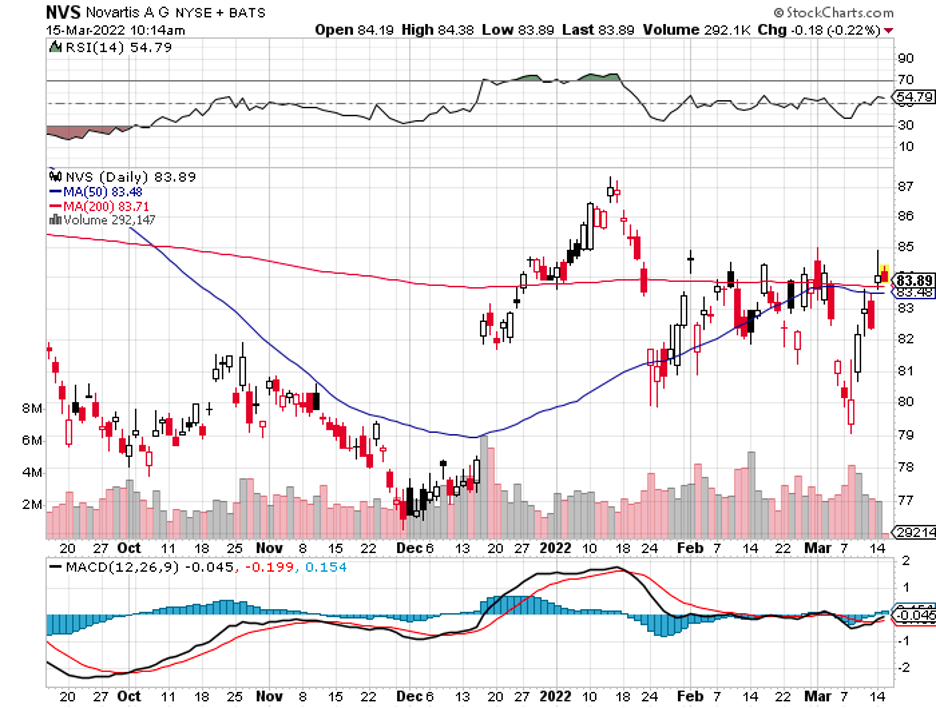
Mad Hedge Biotech and Healthcare Letter
March 15, 2022
Fiat Lux
Featured Trade:
(AN UNDER-APPRECIATED STOCK WITH A BOATLOAD OF CASH)
(BMY), (CRSP), (VRTX), (BLUE), (GILD), (NVS)

Warren Buffett is nothing but a dyed-in-the-wool type of investor. A key strategy in his success is to target companies with notably solid fundamental businesses but with shares trading at a bargain or at least a discount in relation to their intrinsic value.
Needless to say, this value-oriented tactic has worked well for roughly six decades, with Berkshire’s stock delivering total returns of 6,450% on its capital.
Taking a cue from the Oracle of Omaha’s playbook, let’s take a look at one of the cheapest biotechnology and healthcare stocks in Berkshire’s portfolio to date and see how it has been performing.
At a hair below eight times its forward earnings, Bristol Myers Squibb (BMY) comes out as Berkshire’s third-cheapest stock holding overall.
This pharmaceutical giant, which has a market capitalization of $144 billion, is the sixth-biggest in the list of what is informally called the “Big 8” US pharma firms.
However, BMY’s stock had fallen by -2% in the past 12 months after experiencing some genuine momentum in 2021 when it reached $69 in August. The share price fell to $54 in December. It has since recovered and is now at $65.
A primary reason for investors snubbing this pharmaceutical giant is the impending loss of market exclusivity of three of its best-selling treatments, Revlimid, Opdivo, and Eliquis.
Although it’s reasonable to be anxious over these patent expirations, BMY has developed a great plan to not simply offset the future decline in sales but also to sustain the momentum of its top line all the way until 2030.
Basically, BMY has lined up multiple new drug launches spaced in the following years, with a number of these candidates expected to become potential blockbusters.
Another key part of the company’s growth strategy is acquisitions.
One of the significant moves BMY executed in recent years is its whopping $74 billion acquisition of Celgene in 2019, which is expected to bolster its immunology and oncology sectors. This was immediately followed by a $13 billion buyout of MyoKardia in 2020, which would expand its cardiovascular roster.
Celgene's deal granted BMY a valuable collection of pipeline assets, which the company has been leveraging in preparation for the patent cliffs.
Aside from the added $15 billion in annual revenue stream from Revlimid, which BMY used to boost its cash flow and pay off some debts, the company also inherited Reblozyl.
Since the acquisition, Reblozyl has gained approval for beta-thalassemia and anemia patients.
While this is not as groundbreaking as the gene therapies offered by CRISPR Therapeutics (CRSP), Vertex (VRTX), and even bluebird bio (BLUE), this treatment can still reach peak sales of $2 to $4 billion annually.
Another Celgene candidate poised to become an additional revenue stream for BMY is Inrebic, a JAK2 inhibitor created for myelofibrosis and polycythemia vera. This is projected to rake in $400 million in peak sales.
Zeposia, a treatment for autoimmune conditions, has already gained approval for multiple sclerosis and is queued for clinical trials for Crohn’s disease and ulcerative colitis.
If it receives the green light for all three, this is another $3 billion opportunity for BMY.
The inherited assets from Celgene are Breyanzi, a CAR-T therapy approved for large B-cell lymphoma, and Abecma, which is also an approved treatment for multiple myeloma.
These last two treatments are potential blockbusters as well.
Breyanzi’s list price is $410,000, with the therapy estimated to reach $3 billion in peak sales. Meanwhile, Abecma is listed at $491,500 and is projected to peak at $1 billion.
By 2029, BMY expects to develop new revenue streams worth $25 billion from its current portfolio and growing assets.
Looking at the above assets, BMY’s strategy becomes evident.
When BMY acquired Celgene for an exorbitant amount three years ago, the bigger company’s management team showed just how prepared they were to take the hit in the form of substantial debts in exchange for massive steps forward.
Adding to its expansion efforts, BMY has recently completed a deal with Century Therapeutics.
This marks BMY’s major foray into the promising cell therapy space.
While BMY has not concentrated on this sector before, it already has promising candidates in the form of its Celgene assets, Breyanzi and Abecma.
So far, Century and BMY have agreed to develop four different CAR-T cancer therapies on top of expanding the indications for Breyanzi and Abecma.
At the moment, the big pharma names focusing on this sector include Gilead Sciences (GILD) and Novartis (NVS).
This means BMY has a fighting chance to dominate in this market following its strategic collaboration with Century.
If all goes according to plan, BMY’s work with this cell therapy company might even turn out to be as lucrative as its deal with Celgene acquisition.
Overall, BMY has proven itself to be a reliable money-making titan in the biotechnology and healthcare industry.
BMY is a growth machine that consistently comes up with ingenious plans to grow over the years.
From $20.8 billion in 2017, its profits skyrocketed to an impressive $46.4 billion in 2021, indicating a remarkable 123% increase.
Moreover, the company anticipates that its free cash flow will surpass $50 billion by 2024, implying that it’s not worried over the impending loss of patent exclusivities and flexing its ability to generate a boatload of cash to complete even more collaborations and acquisitions.
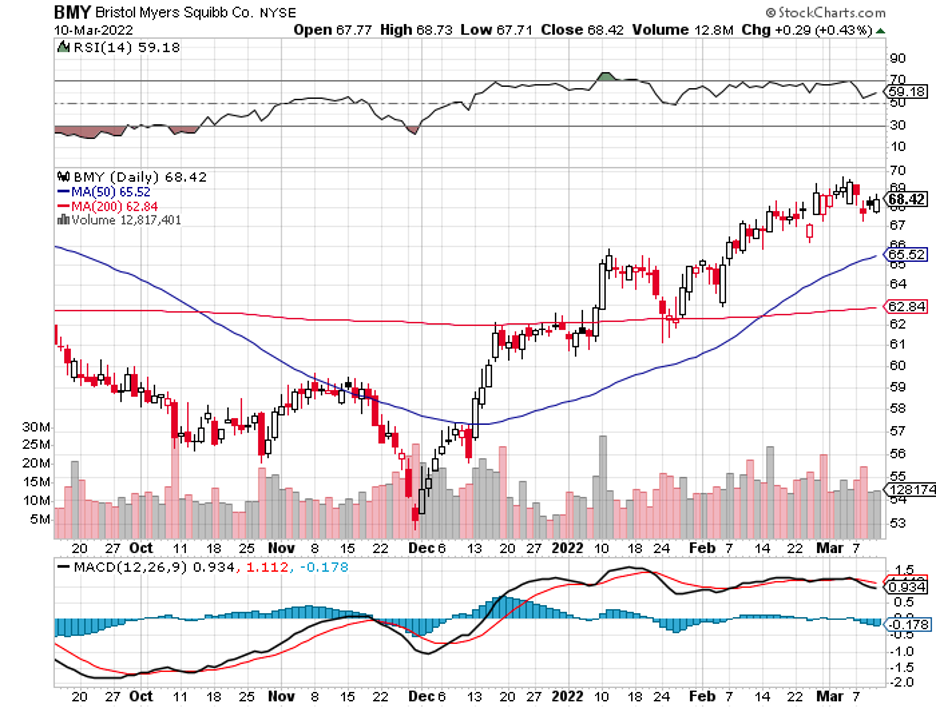
Mad Hedge Biotech and Healthcare Letter
February 15, 2022
Fiat Lux
Featured Trade:
(AN EMERGING LEADER IN THE HEALTHCARE REVOLUTION)
(CRSP), (VRTX), (EDIT), (NTLA), (PFE), (NVS), (GILD), (RHHBY), (BMRN), (QURE), (SGMO), (CLLS), (ALLO), (BEAM)

Mankind has always imagined a future filled to the brim with technological advancements serving as the panacea to all our ills.
One of the prevailing ideas focuses on the developments found in the healthcare sector.
Movies, television shows, graphic novels, and books have all pictured a world with such revolutionary technologies capable of not only diagnosing but also curing any and all types of diseases.
Since the introduction of these ideas, many have believed that these would remain in the fictional universe. However, these “ideas” have slowly transformed into reality.
One of the biggest indicators that we’re heading in that direction is the 2020 Nobel Prize in Chemistry by Jennifer Doudna and Emmanuelle Charpentier. The two were recognized for their pioneering work in CRISPR-Cas9.
Basically, Crispr-Cas9 functions like molecular scissors.
What makes this technology incredible is that Crispr-Cas9 can classify a single address out of 3 billion letters within the genome by using only a particular sequence. With this, we can repair thousands of genetic conditions and even offer more potent ways to battle cancer.
This Nobel Prize led to commercializing the 2012 discovery, Crispr-Cas9, at breakneck speed, with gene-editing companies like CRISPR Therapeutics (CRSP), Editas Medicine (EDIT), and Intellia Therapeutics (NTLA) gaining a considerable boost in their values.
Surprisingly, the trajectory of these gene-editing stocks took a tragic turn in 2021.
In fact, the once-upon-a-time-market-darling CRISPR Therapeutics saw its market capitalization brutally shaved off from $8.7 billion to $4.55 billion in the past months.
No matter how we look at it, there’s genuinely no way to sugarcoat the reality: the market has been second-guessing CRISPR Therapeutics’ ability to truly deliver on its promise.
That is, investors have started to wonder whether the company’s early stage success would amount to anything commercially.
CRISPR Therapeutics is currently working on a treatment that would implant tumor-targeting immune cells on cancer patients. The company is also prioritizing therapies that could edit cells to treat diabetes.
So far, it has made significant progress in developing treatments for a genetic disorder called sickle cell.
In the US alone, at least 100,000 people suffer from sickle cell disease, with 4,000 more born every year. Conservatively, we can estimate at least 3,000 patients availing of this one-time treatment at over $1.6 million a pop.
To date, CRISPR Therapeutics has five candidates under clinical trials for diseases like B-thalassemia, sickle cell disease, and other regenerative conditions.
It has four more queued, which target diabetes, cystic fibrosis, and Duchenne muscular dystrophy.
Compared to its rivals in the space, it’s clear that CRISPR Therapeutics is ahead when it comes to product development and trials.
Two of its candidates, transfusion-dependent beta thalassemia treatment CTX001 and sickle cell disease therapy CTX110, have already been submitted for clinical tests for safety and efficacy.
Recently, Vertex (VRTX) boosted its 2015 agreement with CRISPR Therapeutics by 10%, with the deal reaching $900 million upfront to push for quicker results in developing CTX001.
This is a crucial move for Vertex, but more so for CRISPR Therapeutics as CTX001 holds a highly lucrative addressable market.
The additional funding significantly widened the gap between the Vertex-CRISPR team and bluebird bio (BLUE) in the race to launch a new gene-editing therapy targeting sickle cell disease and beta thalassemia.
To sustain its growth, CRISPR Therapeutics’ strategy is to develop drugs that only require mid-level complexity but can rake in generous financial rewards.
This is a similar tactic used by bigger and more established biotechnology companies like Pfizer (PFE), Novartis (NVS), and Gilead Sciences (GILD).
Evidently, this strategy is a great way to ensure cash flow.
Aside from its earnings from the commercialization of these products, CRISPR Therapeutics can also attract larger companies to buy the intellectual property of their breakthrough treatments.
After all, startups generally get 100% premiums in contracts with Big Pharma.
Good examples of this are Novartis that bought AveXis and Roche’s (RHHBY) purchase of Spark Therapeutics.
The Roche-Spark agreement led to the first ever FDA-approved treatment since gene therapy trials started in the 1990s. It was for the genetic blindness therapy Luxturna, which received the green light in 2017.
The second approved treatment was a muscle-wasting disease therapy Zolgensma, which was the fruit of the Novartis-Avexis acquisition.
Both conditions are rare, but the financial rewards are impressive.
At $2 million for each treatment, Zolgensma sales reached $1.2 billion annually. At the rate the therapy is selling, Novartis estimates that Zolgensma will surpass the $2 billion mark in 2021.
Novartis and Roche aren’t the only ones partnering with smaller gene editing companies.
Pfizer has been working with biotechnology companies BioMarin Pharmaceutics (BMRN) and UniQure (QURE) to develop a treatment for blood-clotting disorder hemophilia.
The COVID-19 frontrunner is also collaborating with Sarepta Therapeutics (SRPT) to come up with a treatment for Duchenne muscular dystrophy.
Gene editing has also served as the foundation for several biotechnology companies out there today like Sangamo Therapeutics (SGMO), Cellectis (CLLS), and Allogene Therapeutics (ALLO).
The market size for gene editing treatments is estimated to be worth $11.2 billion by 2025, with the number rising between $15.79 billion to $18.1 billion by 2027.
This puts the compounded annual growth rate of this sector to be at least roughly 17%.
While this is already groundbreaking with only a handful of companies knowing how to utilize the technology, the gene-editing world has come up with a more advanced technique than Crispr-Cas9.
The technology is founded on the “base editing” or “prime editing” technique, which is the simplest type of gene editing that alters only one DNA letter.
So far, one company holds exclusive rights to this technology: Beam Therapeutics (BEAM).
When the technology became public, Beam stock has increased sixfold since its IPO in February 2020.
This latest development can resolve thousands of genetic diseases. However, it still requires further trials since “base editing” can also trigger damaging responses from the body.
Overall, I think CRISPR Therapeutics is the most promising among these high-risk stocks.
The data from two of its candidates, CTX001 and CTX110, are promising. The added funding from Vertex boosts the confidence of investors that a regulatory approval is well on its way.
The company is also sitting on a massive cash pile and investing aggressively across different rare disease programs.
While the company has yet to be considered a major force in the biotechnology world, the potential multiple successes of its products could generate a company worth hundreds of billions.
This potential alone offers an investing opportunity with a substantial asymmetric advantage for its current share price.
However, bear in mind that the stock is not for conservative investors considering risks.
More importantly, its pipeline requires patience. Hence, CRISPR Therapeutics should be played as a long-term investment.
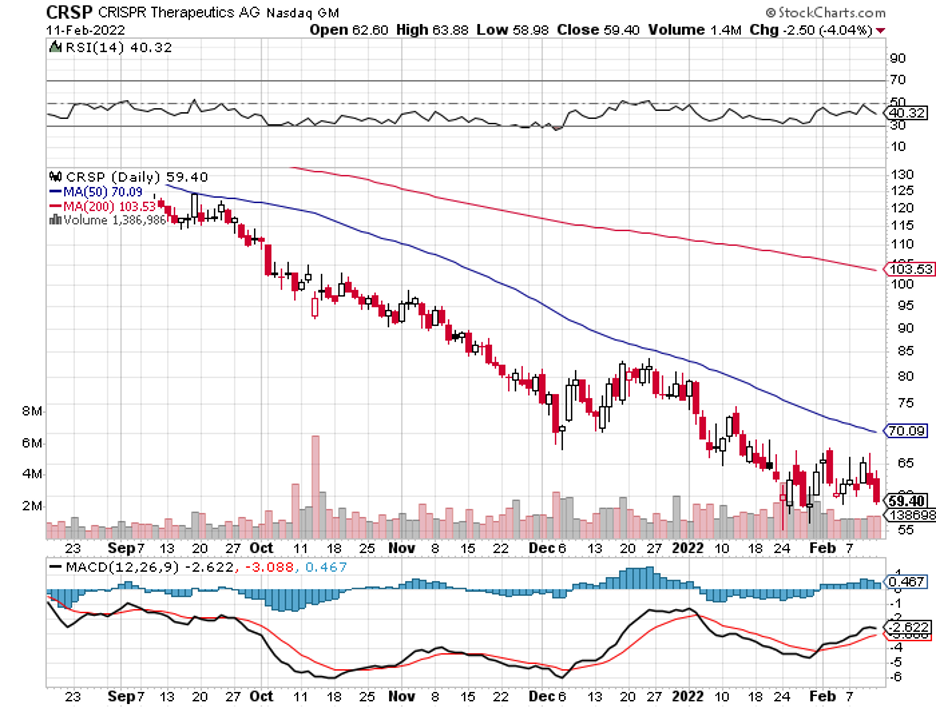
Mad Hedge Biotech and Healthcare Letter
February 1, 2022
Fiat Lux
Featured Trade:
(A SHIFT IN NEUROSCIENCE BIOTECH)
(BIIB), (AXSM), (PFE), (BMY), (MRK), (NVS), (ABBV), (GSK), (JNJ), (LLY), (RHHBY), (TAK)

Industry experts typically describe mergers and acquisitions as the life force that propels the biotechnology and healthcare sector forward.
Based on that description, it’s safe to say that the segment’s health has plummeted, considering the sluggishness observed last year.
In 2021, the M&A of this industry had fallen to one of its lowest recorded levels in history.
During this period, the deals only amounted to $108 billion for the entire year. This number was approximately 40% of the total recorded in 2019.
Despite the sluggishness in 2021 and the relatively slow start in 2022, this year is still projected to push the would-be buyers into more aggressive action.
After all, several key products are facing patent expiration before this decade ends.
The list includes Big Pharma players like Pfizer (PFE), Bristol Myers Squibb (BMY), Merck (MRK), and Novartis (NVS).
This means that a massive deal might be on the horizon, pretty much when AbbVie (ABBV) executed its jaw-dropping $63 bill acquisition of Allergan in 2019 following its problems with generics competing against its blockbuster drug Humira.
Aside from patent protection concerns, another factor in play is the intense competition in lucrative research sectors such as immunology, neurology, rare diseases, and oncology.
Add to this the constant pressure of Congress to pull down drug prices, and it becomes apparent why companies—big or small—turn to mergers and acquisitions for survival.
Simply put, biotech and healthcare companies have no other choice but to be aggressive in looking for external innovation to secure the continuous transformation of their businesses.
On that note, I think there could be major acquisitions to be announced in 2022.
One deal I’m looking forward to is Biogen’s (BIIB) potential acquisition of Axsome Therapeutics (AXSM).
To remain competitive in the neuro stage, Biogen must keep up with the times—and a deal with Axsome might just be the solution.
Axsome’s size and price, with a market capitalization of $992 million, appear to be just the right fit for Biogen to gobble up.
More importantly, its portfolio is an excellent fit for Biogen. Both focus on neurological diseases, making their pipelines complementary to each other.
So far, Axsome has several leading candidates in the clinical stages.
One is AXS-05, which is a treatment for major depressive disorder (MDD).
Apart from MDD, this candidate is under late-stage review to target Alzheimer’s disease agitation.
In addition, Axsome is looking to advance AXS-05 in late-stage trials for smoking cessation therapy.
Needless to say, AXS-05 would go hand in hand with Biogen’s own approved, albeit controversial, Alzheimer’s drug Aduhelm.
Another promising candidate is AXS-07, a potential competitor of Pfizer and Novartis’ migraine medication. This drug has been submitted for FDA approval and might be launched by the second quarter of 2022.
There’s also AXS-12, which is a narcolepsy treatment candidate, and AXS-14, which is geared towards fibromyalgia. Both candidates are slated for FDA review by the third or fourth quarter of 2022.
For over 20 years, even the biggest and most powerful drug companies have stayed away from working on treatments specifically for the brain and central nervous system (CNS).
That’s not surprising considering the sheer number of failed programs in neuroscience, pushing drugmakers to believe that we still don’t have sufficient data on the subject, so the money might be better spent elsewhere.
Nowadays, though, the CNS landscape is starting to shift.
GlaxoSmithKline (GSK) recently embarked on reviving its CNS program by striking a $700 million deal with a smaller biotechnology company called Alector.
Meanwhile, Pfizer and Novartis reached an agreement with Biohaven Pharmaceuticals for the latter’s migraine treatment and Parkinson’s drug.
Aside from these, Johnson & Johnson (JNJ), Eli Lilly (LLY), Roche (RHHBY), and Takeda (TAK) are anticipated to secure CNS-centered deals soon.
Despite the lower number of M&A deals last year, the volume of strategic collaborations in the neuroscience sector climbed by about 50% in 2021 compared to its 2020 performance.
By 2022, this space is projected to become even more investable, considering the number of biotechnology companies focusing on CNS. Watch out for blockbuster deals in this sector.
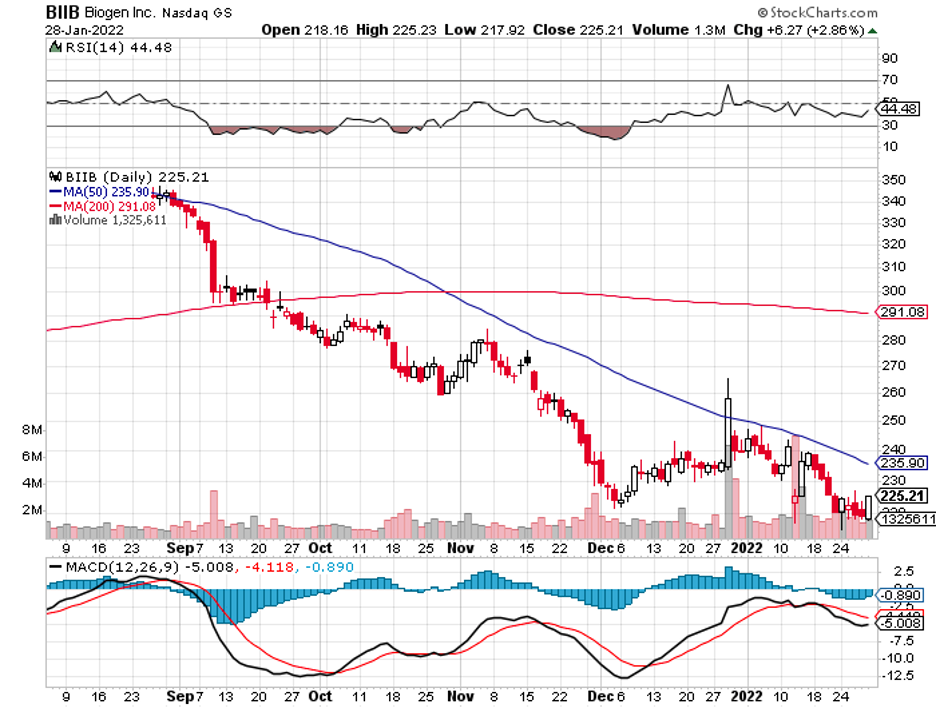
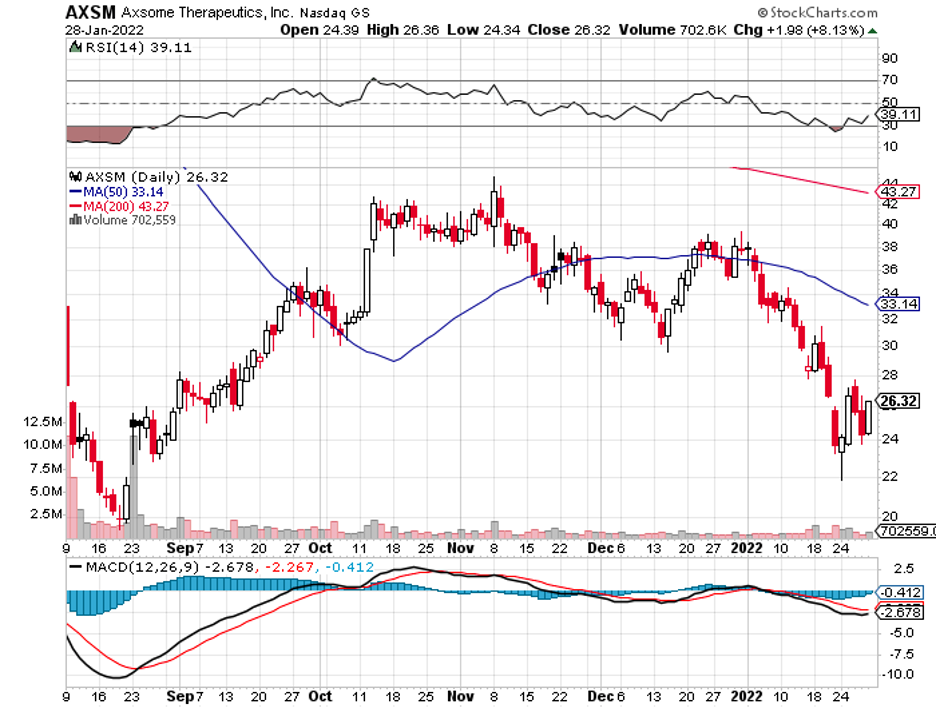
Mad Hedge Biotech and Healthcare Letter
October 21, 2021
Fiat Lux
Featured Trade:
(A DIVIDEND ARISTOCRAT THAT DELIVERS LIKE CLOCKWORK)
(JNJ), (PFE), (MRNA), (BNTX), (NVS), (RHHBY), (MGTX)

There have been two narratives as far as COVID-19 vaccine developers go. One story centers on companies with fortunes essentially built and exploding thanks to their COVID-19 vaccines, like Moderna (MRNA), Novavax (NVAX), and BioNTech (BNTX).
The second story involves larger biopharmaceutical companies, such as Johnson & Johnson (JNJ) and BioNTech’s partner, Pfizer (PFE), which barely felt their shares move in the past 18 months.
While it’s easy to understand the excitement over the achievements of the likes of Moderna, is it reasonable for Pfizer and JNJ investors to feel bad over the lack of movement in their shares?
Not at all, especially in the case of JNJ.
After all, these huge companies have decided to sell their vaccines on a not-for-profit basis until the major wave of the pandemic ends—a move that can be seen as a sound strategy for JNJ to rebuild some goodwill especially following the recent scandals involving the company.
Nevertheless, JNJ might still get a boost (pun intended) from its COVID-19 vaccine booster shots.
Just last week, a prominent advisory committee to the US FDA unanimously voted to recommend the booster shots, which likely means that the 15 million people who got jabbed with JNJ’s candidate will get a second shot as well.
If the FDA agrees with this recommendation, then the boosters could be available within the month. This comes after the agency also approved booster shots from Pfizer-BioNTech and Moderna.
Last month, the US government decided to provide Pfizer booster shots to the older population and high-risk groups, with Moderna following suit almost immediately.
So far, there have been 8 million people who have already received their Pfizer booster doses, while 1.6 million got the third dose for Moderna.
This is another lucrative market for vaccine makers, considering that to date, there are over 104 million people vaccinated with Pfizer, roughly 69 million with Moderna, and approximately 15 million with JNJ.
Amid the talks about the boosters, JNJ stands firm that its vaccine’s potency increases over time and doesn’t wane, unlike Pfizer’s candidate. This means there’s no urgency for a booster shot when it comes to JNJ’s candidate.
Nevertheless, considering that JNJ isn’t exactly attempting to earn from its COVID-19 vaccine aggressively, there’s no point in investors worrying about this issue too much.
The fundamental aspects that will impact the stock price can be found elsewhere.
One of the more exciting projects of JNJ lately is its move to become more active in the gene-editing field.
Following the buzz from the multi-billion dollar acquisitions of companies like Novartis (NVS) and Roche (RHHBY) several years ago, it looks like JNJ might be the next big name to enter the fray.
Since 2018, JNJ has been working closely with a small-cap gene-therapy company called MeiraGTx Holdings (MGTX).
While highly secretive of the details, MeiraGTX, which has a market capitalization of just below $600 million, has been developing a gene-regulation technology—an innovation that could revolutionize gene therapy.
For context, this kind of innovation was applied to Novartis’ Zolgensma, a one-time treatment for spinal muscular atrophy worth a whopping $2.1 million—the most expensive medication in the world.
In terms of MeiraGTX’s work with JNJ, the two companies are focusing on creating therapies for various eye diseases. Looking at their timeline, the first candidate should be ready by 2023.
While there remain questions about its COVID-19 vaccine candidate, their earnings are expected to reach roughly $2.5 billion or merely 2.65% of JNJ’s total revenue. This would barely make a dent in the overall performance of the company.
What comes clear in the performance reports from the company is that its core business remains the primary moneymakers.
In the second quarter of 2021, JNJ recorded $23.3 billion in sales, reporting a notable 27.1% from the $18.3 billion revenue it generated from the same quarter in 2020.
Its gross profit also climbed from $11.7 billion to $15.7 billion, showing a 33.8% improvement. As for its EPS, it skyrocketed by 72.8% year-over-year from $1.36 to $2.35.
Meanwhile, JNJ’s guidance for 2021 has been updated to reflect its expected 13.% to 14.% year-over-year increase between the range of $93.8 billion and $94.6 billion.
Its pipeline and current portfolio also all but guarantee that JNJ will deliver mid to high single-digit earnings in the years to come.
Another indicator of the stock’s quality is its dividend record, with JNJ priding itself on a 59-year streak—making it an undisputed dividend aristocrat.
Overall, I see JNJ as an impressive $433 billion behemoth in the biopharmaceutical sector. The company has been consistent in delivering remarkable top and bottom lines every quarter.
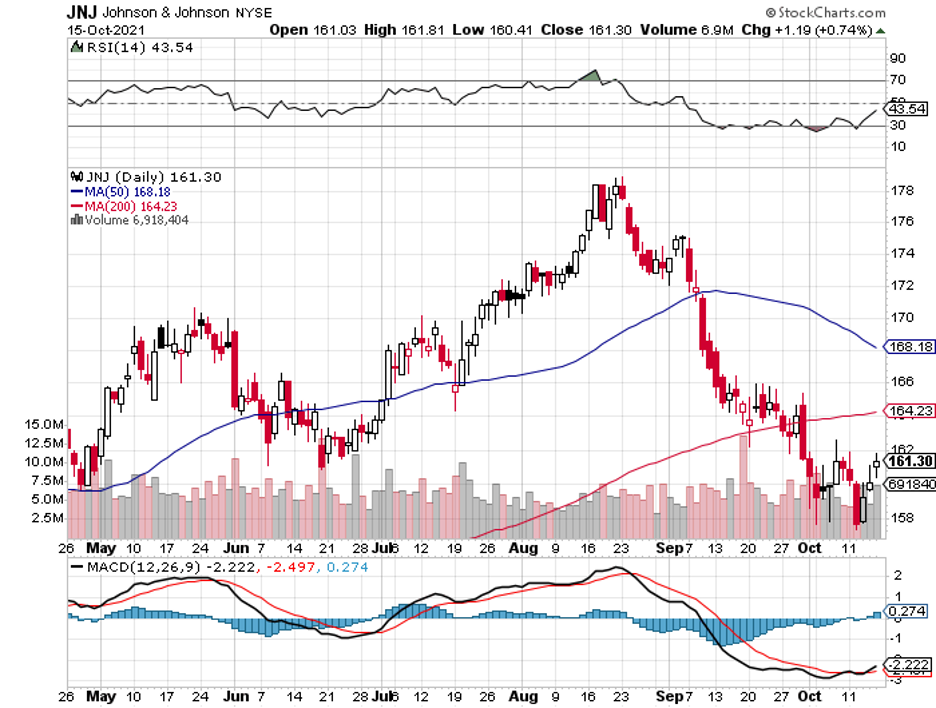
Legal Disclaimer
There is a very high degree of risk involved in trading. Past results are not indicative of future returns. MadHedgeFundTrader.com and all individuals affiliated with this site assume no responsibilities for your trading and investment results. The indicators, strategies, columns, articles and all other features are for educational purposes only and should not be construed as investment advice. Information for futures trading observations are obtained from sources believed to be reliable, but we do not warrant its completeness or accuracy, or warrant any results from the use of the information. Your use of the trading observations is entirely at your own risk and it is your sole responsibility to evaluate the accuracy, completeness and usefulness of the information. You must assess the risk of any trade with your broker and make your own independent decisions regarding any securities mentioned herein. Affiliates of MadHedgeFundTrader.com may have a position or effect transactions in the securities described herein (or options thereon) and/or otherwise employ trading strategies that may be consistent or inconsistent with the provided strategies.
This site uses cookies. By continuing to browse the site, you are agreeing to our use of cookies.
OKLearn moreWe may request cookies to be set on your device. We use cookies to let us know when you visit our websites, how you interact with us, to enrich your user experience, and to customize your relationship with our website.
Click on the different category headings to find out more. You can also change some of your preferences. Note that blocking some types of cookies may impact your experience on our websites and the services we are able to offer.
These cookies are strictly necessary to provide you with services available through our website and to use some of its features.
Because these cookies are strictly necessary to deliver the website, refuseing them will have impact how our site functions. You always can block or delete cookies by changing your browser settings and force blocking all cookies on this website. But this will always prompt you to accept/refuse cookies when revisiting our site.
We fully respect if you want to refuse cookies but to avoid asking you again and again kindly allow us to store a cookie for that. You are free to opt out any time or opt in for other cookies to get a better experience. If you refuse cookies we will remove all set cookies in our domain.
We provide you with a list of stored cookies on your computer in our domain so you can check what we stored. Due to security reasons we are not able to show or modify cookies from other domains. You can check these in your browser security settings.
These cookies collect information that is used either in aggregate form to help us understand how our website is being used or how effective our marketing campaigns are, or to help us customize our website and application for you in order to enhance your experience.
If you do not want that we track your visist to our site you can disable tracking in your browser here:
We also use different external services like Google Webfonts, Google Maps, and external Video providers. Since these providers may collect personal data like your IP address we allow you to block them here. Please be aware that this might heavily reduce the functionality and appearance of our site. Changes will take effect once you reload the page.
Google Webfont Settings:
Google Map Settings:
Vimeo and Youtube video embeds:
